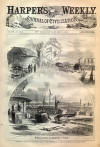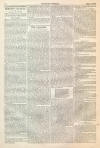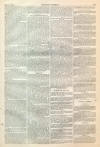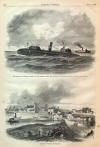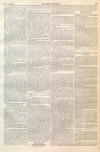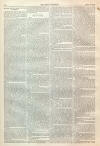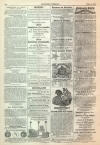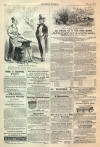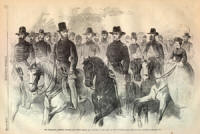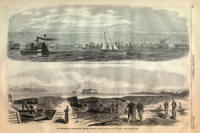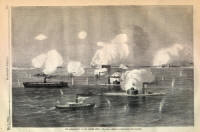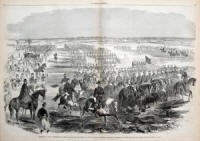Ironclad Warfare
|
|
This Site:
|
HARPER'S WEEKLY. [MAY 2, 1863. 274 HARPER'S WEEKLY.SATURDAY, MAY 2, 1863."Scarcely any paper is doing so much for UNION and LIBERTY as Harper's Weekly."—Boston Commonwealth. IRON-CLADS.THE fight at Charleston is the third practical test of iron-clad vessels. The first was the Merrimac drama, which proved that iron-clad vessels could resist ordinary shot; that iron-clad vessels with beaks could sink wooden vessels without suffering any serious injury; and that two iron-clad vessels might fight each other at close quarters without inflicting much damage. The second was the bombardment of Fort McAllister, which proved that iron-clads of the Monitor type can bombard a fort within easy range, and sustain a pretty heavy fire without fatal injury. The third experiment proves that these same vessels can stand the heaviest fire ever known in the history of artillery at a distance of from 300 to 750 yards without being disabled. Of the seven Monitors which took part in the Charleston fight only two were injured to any extent. These two received blows on the turret which impeded its revolution. None of the hulls were perforated, nor did a ball go through any single turret. Not a man on board of any of them lost his life. Yet these vessels, carrying only fourteen guns, were exposed, at a distance of from 300 to 750 yards, for a period of over half an hour, to a fire of 300 heavy guns, mounted in casemate batteries and heavy earth-works, and served with precision and vigor. It is admitted on all sides that the fleet could have passed Fort Sumter had they been able to override the obstructions, consisting of stakes, nets, and other artificial barriers armed with torpedoes. We have thus determined a most important fact in naval warfare, which is, that vessels can be constructed of iron, or with iron plating, which can run the gauntlet of any batteries in existence. This is progress, undoubtedly; but not enough has been done as yet. While we have been building Monitors the rebels have not been idle. They have brought to perfection the science of defensive warfare, as applied to the defenses of a port. The combination of piles, stakes, nets, cordage, and torpedoes, which blocked the entry of Charleston harbor on 7th April was without precedent, and, judging it by its effects, it was a perfect success. We may note the fact as one to be treasured up for use hereafter, in the event of war with Europe; but meanwhile the much more important and immediate duty devolves upon us of discovering a means of demolishing such submarine antagonists. It was understood, before the attack on Charleston was made, that Captain Ericsson had invented a machine called a "devil," which was nothing more than a gigantic torpedo, borne on a submarine raft and fired by a submarine battery; and that this machine would quickly demolish any obstructions or torpedoes lying in the line of its fire. For some reason or other it does not appear that these "devils" were used at the attack on Charleston. Three of the four sent down to Port Royal are said to have been lost. The fourth was an inoffensive spectator of the conflict. It behooves the Navy Department to ascertain why the fourth "devil" was not called into play on 7th; and if the judgment which prevented its employment be shown to have been sound, it is incumbent on us to make such improvements in its structure as shall render it capable of performing the service for which it was intended. It is easier to blow up obstructions in a channel-way than to establish them. The fate of the Keokuk; the injuries sustained by the Ironsides, though at a considerable distance from the rebel forts; and the deep indentations made by the Anglo-rebel shell and shot in the Monitor turrets, demonstrate clearly that an iron shield, to resist a fire of 8 or 10 inch rifled shot at close quarters, must be rather over than under ten inches of solid iron. This is far heavier plating than is worn by any iron-clad vessel afloat, except the Monitors. The French and English iron-clads, of the Warrior and La Gloire type, carry plates of from 4 to 5 inches in thickness. We presume that at a distance of 500 yards, every well-aimed rifled shot from our large guns would go through this plating as easily as an old 12-pounder, fired from an old smooth-bore gun, penetrated the wooden sides of an old three-decker. Under these circumstances one can not but admire the simplicity of the Navy Department in equipping the Roanoke for sea, at a vast expense. This vessel carries 4 1/2 inch plating, and her sides stand 8 feet out of water. Nothing could be better conceived for a target; and a vessel like the Montauk or Passaic would probably sink her in fifteen minutes without sustaining any injury. The lessons taught by the three practical experiments of iron-clads which we have made are these: 1st. That in future naval combats no vessel should be entered that is not iron-clad. 2d. That to be of service the plating on the exposed portion of the vessel should be not less than ten inches thick. 3d. That however iron-plating may increase the defensive power of a vessel, it does not increase its aggressive power against forts, and that—Providence being always on the side of the heaviest artillery—we can not expect to succeed if we fight 300 guns with 14; but that we must increase the number of our guns, that is to say the number of our vessels, so that when next we fight we may fire as many tons of iron as the enemy. 4th. That iron-clads are as helpless against submarine obstructions as wooden vessels, and that the explosive power of powder must be developed in some new machine, akin to Ericsson's "devils," to destroy or remove such obstructions. THE LOUNGER.THE NATIONAL ACADEMY OF DESIGN.THE war so absorbs the public mind—our literature in every form is so full of it—it is so much in our hearts and mouths—that, as you ascend the staircase to the gallery of the National Academy's thirty-eighth annual exhibition, you will find yourself asking whether the noise of war has not reached the quiet studios of the painters also, and whether it will make itself felt in art, as in all other forms of life. The question will be answered almost before you have paid your annual respects to Mrs. Croker, who sits, as of old—and long may she sit—at the receipt of custom. For immediately upon your left, as you enter, three drawings in water-color arrest your eye. "Who goes there?" they all say to you by their vigor, breadth, and character, as the guard in No. 432 shouts to the appalled contraband, who drops his bundle and stick in overwhelming consternation. These pictures, Nos. 432, 434, and 435, are by Thomas Nast, an artist not unknown to the friends of this paper for the masterly sketches with which he has illuminated its pages, especially the picture in commemoration of the Emancipation Proclamation. Beside the guard there are The Intelligent Contraband and The Reliable Gentleman, both products of the rebel region. The broad-faced, humorous intelligence of the contraband, and the "gentleman," who is a characteristic specimen of the class of "gentlemen" which is produced only at the South, and seems crossed between the Yankee and the Spanish Mexican—Ichabod Crane and a guerrilla chieftain —are all fresh and living illustrations of the time; nor have we any where seen a finer type of the loyal soldier in this war—the soldier who has not forfeited his rights of a citizen, despite Governor Seymour—than the picket whose challenge so dismays the contraband. There is a charming grace and ease in all three sketches. And indeed we may as well say at the door that the Exhibition is of an unusual general excellence. There are no very remarkable works, none that hopelessly surpass all the rest; but the average of excellence is higher. There are fewer positively bad pictures upon the walls than usual. And the gallery of smaller works is truly a "gallery of gems." The phrase is original, but we hope it will not be less acceptable for that reason. Meanwhile there are other pretty things to see in the vestibule, where Nast's sketches hang. Here, for instance, is No. 442, a bank of violets in spring, by W.H. Furness, Jun., of Philadelphia, whose portrait of his father two years since was an earnest of remarkable skill and power, and whose portrait of a lady, No. 17, in the first gallery, is one of the finest in the present exhibition. No. 270, in the last gallery—A Boy Reading—has the same thoughtful, conscientious treatment, simple and true. Mr. Furness has no apparent mannerism—no tricks to unlearn. In the vestibule, too, are a pair of butterflies, Nos. 455 and 456, painted from nature by Mr. Joseph Bridgham, who reproduces the astonishing brilliancy of the original hues with great skill and delicacy. Mr. Saintin, in No. 447, has a cabinet portrait of Kensett, the painter, whose genial aspect welcomes every comer to the rooms. Calvert Vaux, in the same room, has two plans of villas, Nos. 450 and 454, which are rich without gingerbread, and effective without niggling. Look about the vestibule, Don't suppose that there is nothing to see because it is a vestibule, or because the works are small. The war confronts us again as we enter the large gallery and turn to the right to begin. No. 3 is a Loyal Refugee, by Vincent Colyer, who went as a teacher to North Carolina, and paints what he knows. The refugee is a slave boy escaping to our lines; and the picture opens the Exhibition with a thrill, for we remember as we look at it that the flag of the United States is at last what it was meant to be, the flag of freedom to all mankind. Bierstadt's Mountain Brook, No. 6, is charming. The mossy rocks and the smooth green water delight the study which they invite. So Sunrise at Narraganset, No, 10, by W. S. Haseltine, is more a technical study than a picture, but it has the reddish warmth of the Narraganset shore, and sparkles cheerily. Mr, Gifford's Kauterskill Clove, No. 15, attracts much attention. It is the representation of an exceptional effect of sunlight in autumn. The shaggy mountain sides are impressive, but the mind is in constant doubt about the light. So in the next section, No. 90, Mansfield Mountain, Sunset, a careful work of Mr. Gifford's, is another peculiar effect, full of splendor. But both of these pictures, and No. 385, Como, in the small gallery, are almost sensational. Such aspects of nature are so infrequent that you doubt whether you are not arrested by the novelty of the effect rather than by the accuracy of the work; and when they are constantly selected by a painter they become a mannerism. Thus No. 385 would be recognized any where as a Gifford, not by its real merit, but by a purely mannered treatment. On the other hand, his No. 409, in the same room, Baltimore, 1862, Twilight—one of the pictures of the war, in which the painter has taken his part—is to us the most pleasing of his works in the Exhibition. The solemn figure of the sentry against the bright evening red—the spires and domes of the distant city—the guns and piles of balls—and the long line of the parapet, are simply and exquisitely done. The picture is a poem. Mr. Gifford is a painter of so much talent that he can do nothing ill; but is he not too fond of a superficial effect, while he has all the power necessary for the simplest and truest impression? Mr. John Lafarge's Flowers in a Lacquer Bowl, No. 21, are admirable. The moist, rich, crisp fullness, of a mat of blossoms is broadly and beautifully done. In No. 53 we have Healy's portrait of the poet Longfellow. It is a capital likeness, and painted with great force. Healy has two other portraits of the heroic size and treatment, No. 181, Dr. O. A. Brownson, and No. 195, The Archbishop of Baltimore. If they were both priests we should say leonine and feline. Certainly the doughty Doctor looks like a very battering-ram of the Church. But his intrinsic good-humor shines and sparkles through the strength. The three are very effective portraits, No. 87, A Lady, is a portrait by Mr. Stone, whose skill in handling is mingled with a certain rich and luxurious taste which makes his portraits as picturesque as Sir Peter Lely's. If, standing before the picture, the Lounger throws down his glove and says that no Lely portrait of Charles's court is lovelier than this, even to the rippling love-locks, who will dare pick it up? Will it be some one who puts June roses and muslin and blue ribbons against elaborate coiffure, rich stuffs, pearls, and the dainty fan, and therefore declares for No. 112? It is called A Morning Walk, by Thomas Hicks, and is one of the brightest and best of his works. A girl in a garden, not "Queen rose of the rose-bud garden of girls," but a day lily rather, clad in the airiest muslin, with a thin trickle of blue ribbon around her neck; fresh, dewy, buoyant, swinging with lithe grace into the morning air. Let him who will quarrel with the hands in this portrait. They shall not unclasp for him, and he had better betake himself out of the spring sunshine into No. 111, The Last Days of October, by J. R. Brevoort, where the brightness is the hectic of death. It is one of the many autumn pictures in the Exhibition; Mr. Whittley's Autumn, New Jersey, No. 121, is another, near by. They are both characteristic scenes and pleasant pictures. Mr. Kensett, in No. 123, Morning in the White Mountains, shows that clear, masterly, healthy vigor and exquisite feeling which keep him still pre-eminent. A lichened mossy crag, sharp cut against the sky, rises from the foliage. The broad daylight, the ample air, the careful and delicate leaf work, the hard, gray rock, and the pervasive firmness and fineness of handling, make Mr. Kensett characteristically represented by this single work. This is true, also, of Elliott in No. 143, and of Huntington, President of the Academy, in No. 137. Trees that every year bear good fruit do not need the fostering attention due to saplings, so we pass on. But if No, 152, Marching Along, by J. G. Brown, be the blossom of a sapling, what delicious fruit we shall have by-and-by! It is one of the most charming pictures in the Exhibition. A procession of children are marching over a rustic bridge, escorting perhaps a Queen of May, whom Uncle Kuhleborn will surely seize from beneath the plank. The variety of artless and bewitching expression, from the rapt sweetness of the flower-crowned maid to the little hind-captain in petticoats, with his solemn effort to share the fun, is delightful. The spirit of the scene is in Emerson's musical and beautiful lines, "With children forward and behind, Like Cupids studiously inclined; And he, the chieftain, paced beside The centre of the troop allied, With sunny face of sweet repose. To guard the babe from fancied foes, The little captain innocent Took the eye with him as he went; Each village senior paused to scan And speak the lovely caravan." In this room, also, is one of the large landscapes of the Exhibition, Gibraltar, No. 136, by S. Colman, Jun. It is an open, placid, daylight portrait of the famous rock, a historic landscape. Huntington's Ichabod Crane and Katrina Van Tassel, No. 146, is fully in the delightfully humorous spirit of the story, and Gray's Pride of the Village, No. 128, is a charming pendant. Any lover of Irving would be very lucky in owning the two pictures, interesting not only from their subjects, drawn from his pages, but from the association of the two painters and friends, the President and Vice-President of the Academy. Near by, No. 130, is a small picture of Gray's, America in 1862. A kneeling manly figure of a slave looks up into the eyes of the genius of America, who breaks his chains with one hand and offers him a sword with the other. The motto of the State of Virginia might well be engraved beneath it, Sic semper tyrannis. Mr. Gray deserves the earnest thanks of every worthy American for the noble aspect which he has given to the slave—a fine foreshadowing of the benediction of Justice to a race called to resume its manhood. In No. 157, Mr. William Morgan, a name unknown to us hitherto, has a portrait group, figures of cabinet size, with an interior. Of one of the likenesses, at least, we can speak in high praise. But we must turn abruptly from the third section of the large gallery, looking in as we go upon the collection in the "Small Gallery." Here No. 240, the Bridge of Sighs, by Charles Parsons, is a most poetic and admirable picture. The weird dim arches of the bridge, with the dimmer arches of other bridges in the murky distance, the dreary silence of the water level, and the vague confused roar of the city far above; a blankness and heavy sadness every where, as if the tragic death stirred the air into dull gloom, as the body and rocking boat ripple the river into faint waves, are full of pathos. In this little picture Mr. Parsons has modestly dared, and succeeded. It is not unworthy its subject; and the line of the poem of Hood's which he has placed in the catalogue does not extinguish the impression of' his work. "All that remains of her now is pure womanly." The poem itself is the complement of Burns's "A man's a man for a' that." For it says, with infinite pathetic tenderness, a woman's a woman for a' that. The interest of the picture lies in the sentiment of the whole scene rather than in the figures; and it is one of the most truly imaginative works in the collection. This room deserves a separate notice, which it shall surely have. But meanwhile we must mention Mr. Hennessy's three exquisite little pictures Nos. 323, 334, and 361, and Mr. Winslow Homer's Nos. 255, and 371. The two last are incidents of the camp, treated with perfect spirit and freshness. No. 371, Home, Sweet Home, was marked "for sale" in the catalogue on the first day. But on the second it was labeled "sold." It is a little work of real feeling; soldiers in camp listening to the evening band, and thinking of the wives and darlings far away. There is no strained effect in it, no sentimentality, but a hearty, homely actuality, broadly, freely, and simply worked out. We beg the visitor to the Exhibition not to be confused by the multitude of small works in this room, but to take our word for it that he will be repaid by giving plenty of time to them. It is a collection as full of promise and cheer for American art as any we have ever seen. Next week we will make another tour through the Gallery. FROM A DIARY.THE young gentleman known as the Marquis of Hartington shows his hand. I was reading his speech this morning, when James T— looked over my shoulder and asked me whether I had any doubt now that he wore the rebel badge at the Fifth Avenue ball by deliberate design? "It certainly looks bad for him," I answered. "And how does it look for the ball?" he asked. "What do you mean?" "Why, that a man who has no other claim to attention whatever than that he is the son of an English duke insults host and guests and is allowed to remain in the house." "Ah, yes." "Yes; and that isn't the worst of it." "No?" "Not at all. I do not forget that he was rebuked by a young officer who knew, if nobody else did, that he ought to have been shown the door. Yes, and there was more than one guest who thought the same. The young men of New York did not mean to suffer the insult to pass unnoticed; but they deferred to the claim of the officer, who declared that it was his right to reprove him. But doesn't it seem to you that the host had a certain duty in the case?" "Undoubtedly." "If a gentleman at a party gets drunk and begins to sing an indecent song, the host is the proper person to expel him." "Undoubtedly." "Wasn't this a thousandfold more insolent insult?" "It certainly was. And as you were there, and I wasn't, just tell me, did the host censure this man?" "Not that I am aware. But he felt aggrieved with the young officer for making trouble." "Indeed!" "Yes. And didn't he try to salve the wound to the susceptibilities of this English offender, by asking him to dine the next day or soon afterward?" "Such is the story here at the club." "Didn't he reproach the young American officer for his conduct?" "So I hear." "Well, now, the young Englishman goes home and says that we don't know when we are beaten; that the Union is dissolved; and repeats all the rest of the British slang about us, doesn't he?" " I have just read it." "Who ought, then, to be aggrieved, the host who was angry that the lord wasn't allowed to show his colors unrebuked, or the young officer who was resolved that he shouldn't?" "If you put me on my honor, I say that the event justifies the young man, because it is now clear that the rebel badge was willingly worn." "What reparation can be made him?" "He needs none from all generous and loyal men. They have always applauded his conduct. And I think that the host owes him his warmest thanks for preventing his house being known as a place where an Englishman could insult this country unrebuked." As we were speaking old —, who plays whist at the Disunion Club, joined us. "Pooh, pooh!" said he, "what business is it of ours? It was in a private house." "That indeed," answered James T—; "but it was a public insult, and the whole country knows it. While such things happen it is no wonder that the London Times and all foreigners and rebels suppose that we are not in earnest. If the war is a joke, it is no matter whether every Englishman in the city wears the rebel badge or not. But if it be earnest, and the thousands who have lost friends, sons, husbands, brothers, fathers, and lovers think it is, any man who tolerates such an offense insults them all, and secures further slaughter by encouraging the rebels and their friends to believe that we shall presently come to terms. Of course this young Englishman has said to every body he meets, 'Oh, it's a mere game of brag! Why, I wore a rebel badge in the finest society in New York, among the very people who subscribed heavily for the war two years ago; and when a young fellow in a uniform talked big about it the host was vexed with him, and blamed him the next day. No, no. The war is only a jolly sham with the people at the North. It is real only with the Confederates. Old—, who plays whist at the Disunion Club, grunted and left us. THE ACCOUNT WITH ENGLAND.THE public interest is constantly turned to our relations with England. The unequivocal statement of the British Government by the mouth of Lord Palmerston that it will not be driven by any cry which may be raised "to come down to this House with a proposal to alter the law" is a distinct declaration that it will furnish no remedy for the wrong it commits. What, then, is the wrong? That ships are built and armed and manned in the ports of a friendly neutral to prey upon our commerce; and that already they have almost driven trade front American bottoms. Our claim is, that, a frank and fair enforcement of her own neutrality act would obviate the complaint: and that, beyond her own laws, the law of nations forbids the offense. To this perfectly plain statement the reply of (Next Page) |
||||||||||||||||||||||
|
|
||
|
|
Site Copyright 2003-2018 Son of the South. For Questions or comments about this collection, contact paul@sonofthesouth.net |
|
|
Are you Scared and Confused? Read My Snake Story, a story of hope and encouragement, to help you face your fears. |
||
